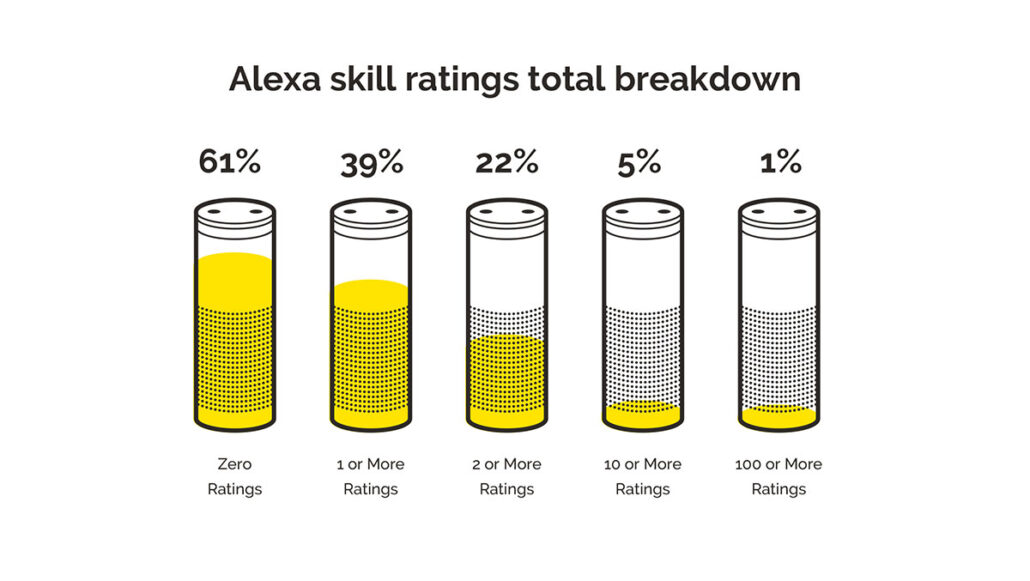Skills and Actions for Voice
Brands are starting to recognise the opportunity in building a skill for Alexa or an action for Google Assistant to ensure they are part of the fast-paced revolution in voice search.
As digital marketing entered the fourth quarter of 2018 Voicebot calculated that more than 3,500 brands had already made the leap to launching an Alexa skill, contributing to the 50,000 skills available for users worldwide. Google Actions number in the low thousands because Alexa got the jump on them in this area, but the tech giant is starting to catch up fast.
Developing a skill is a relatively simple process, supported by two main development platforms Alexa Skills Set and Actions on Google. These services include developer kits which offer guides tailored to a wide array of verticals, along with supplied templates that can greatly simplify and speed up the process.
Say my name, say my name
This ease of access to the market makes it easy for brands to dip a proverbial toe in voice, to see how they might best be able to get consumers speaking their name. With spoken search, it almost goes without saying, brands need to get the public familiar with their product or service, so they ask for them by name when performing voice searches.
Rather than ask Alexa ‘What’s on at the cinema?’ the Odeon chain would prefer people to be asking what their nearest Odeon cinema showing. It is the same for any product. Nike would far rather people ask for the nearest stockist of its Mercurial football boots by name, rather than a generic, ‘Who sells football boots in town?’
Of course, the problem with developer kits being easily accessible, helping tens of thousands of skills to be developed already, is self-evident. The market is saturated with skills and actions, and as Voicebot reports, this means many are sitting around underused and not feeling the love. In fact, nearly two in three do not have a single user rating on Amazon.
A helping voice
The key to being used is being useful. Achieve this, and a brand will increase its chances of being among the one in twenty which is accessed and enjoyed sufficiently to receive ten or more ratings. Of course, another way of looking at this more positively is that by being truly useful and meeting a customer need, brands can stand out because it only takes two or more reviews to be in the top quarter of most-rated skills.
The early big-hitters have been skills that tap into the main uses of voice – to play songs, find out information and hear the headlines. Hence, the likes of Amazon Music, Spotify, Sky News, BBC News and Met Office weather are in widespread daily use. So too are apps that control lighting and heating and Uber is often referred to as a poster child for making it as easy to get a cab as whistling on the street in 1970s New York.
In these cases, it’s fair to say the products and services lend themselves to the voice experience. For those that don’t, brands are having to think a little more creatively to tap into voice. Those brands aren’t generally trying to secure an instant sale but instead serve a need a user has in that moment, raising brand awareness and a heightening the probability of converting the action into a transaction.
For example, Zyrtek has an action and skill that offers a pollen forecast for a user’s area so they know if it’s a day for popping an allergy pill. If the count is high, it’s a natural step to order some of the anti-allergy medication.
US detergent brand, Tide, similarly offers a skill that can offer advice on stains, so someone can ask Alexa or Google how to get red wine out of a work blouse or shirt. Campbell’s does not try to sell people soup directly but instead offers recipe tips.
Make your name the brand they rely on
There has never been more of a need for a brand to ensure it can stand out by helping users. Voice is set to disrupt how the public discovers and engages with brands. Those who do not start small now, and aim big later, will find a rival’s name on the tip of a consumer’s tongue when they have a query and then, later, when they want to place an order.
The developer kits are readily accessible and all brands have to do is identify what wider need could they help customers with that connects to their product? This need not be overtly sales-driven but should ensure the brand name is synonymous with trustworthy support. It’s easier said than done, but if brands can answer that question, it will soon lead to lead to voice commerce sales and not just enquiries.


